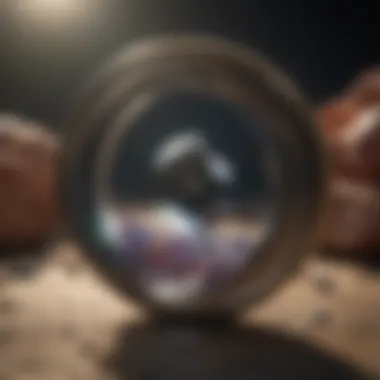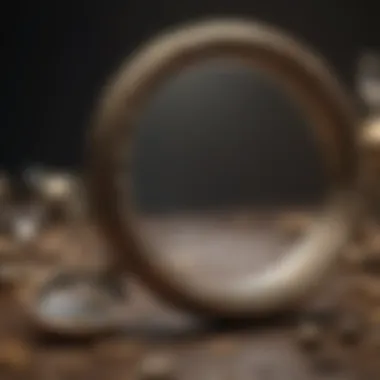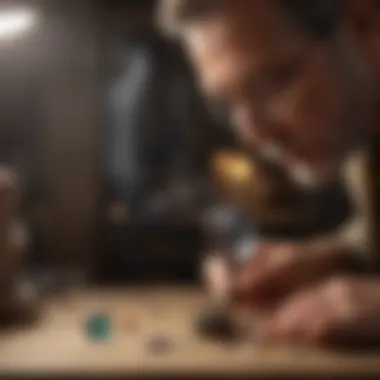Unveiling the Enigmatic Power of the Magnifying Glass in Jewelry Crafting


Rock and Fossil Identification
In the mesmerizing world of jewelry making, the magnifying glass stands out as an invaluable tool, revered by artisans for its ability to uncover the hidden charm and intricate details of precious gemstones. Its historical significance intertwines with its practical applications, elevating it into a masterpiece within the realm of jewelry craftsmanship. The magic of magnification shines a light on the wonders concealed within gemstones, offering a deeper exploration into the artistry of jewelry creation.
Geological Insights
Delving into the geological perspective unveils the intricate formations and processes that shape the rocks and fossils we admire. From the historical significance of these specimens to the groundbreaking discoveries that have shaped our understanding of the earth's history, exploring the world through the lens of geological insights provides a fascinating journey into the heart of the Earth's treasures.
Introduction to the Magnifying Glass
In the realm of jewelry craftsmanship, the magnifying glass stands as a symbol of precision and detail, unrivaled in its ability to unveil hidden intricacies of precious gemstones. It serves as an indispensable tool for jewelers, allowing them to explore the minute facets that define exquisite craftsmanship. This section delves into the historical origins and significance of the magnifying glass, shedding light on its evolution from a simple lens to a sophisticated instrument driving quality assurance and artistic pursuits within the jewelry industry.
Historical Origins
Invention and Evolution:
The inception of the magnifying glass traces back to ancient civilizations where rudimentary lenses were used to magnify objects. Over time, this tool evolved into a critical instrument for craftsmen, enabling them to examine gemstones with enhanced clarity and detail. The invention and evolution of the magnifying glass revolutionized the way jewelry artisans approached their craft, offering a closer look at the hidden wonders within precious stones. Its role in magnifying intricate facets has made it a quintessential choice for jewelry makers seeking perfection in their creations.
Early Uses in Jewelry Making:
The early adoption of magnifying glasses in jewelry making heralded a new era of craftsmanship, allowing artisans to scrutinize gemstones in unprecedented detail. Jewelers utilized these tools to assess the clarity, cut, and color of gemstones, paving the way for enhanced precision in their work. The early uses of magnifying glasses in jewelry making transformed the quality of craftsmanship by facilitating meticulous inspections and ensuring the creation of flawless pieces. While their introduction presented challenges in terms of portability and clarity, their significance in enhancing jewelry craftsmanship remained undeniable.


Significance in Jewelry Craftsmanship
Precision and Detailing:
The significance of precision and detailing in jewelry craftsmanship cannot be overstated, and the magnifying glass plays a pivotal role in achieving unparalleled perfection. By magnifying intricate details, jewelers can meticulously inspect gemstones for imperfections, ensuring each facet is flawlessly crafted. The key characteristic of precision and detailing lies in its ability to elevate jewelry making to a meticulous art form, where every aspect is thoroughly examined to achieve excellence. While the use of magnifying glasses demands patience and skill, the results they yield in terms of precise craftsmanship are unmatched.
Quality Assurance:
Quality assurance stands as a cornerstone of jewelry craftsmanship, with magnifying glasses serving as essential tools for evaluating the integrity of each piece. By scrutinizing gemstones under high magnification, jewelers can detect imperfections, inclusions, or irregularities that may impact the overall quality of the jewelry. The key characteristic of quality assurance lies in its ability to uphold the standards of excellence, assuring customers of the impeccable quality of the jewelry they acquire. Despite the time-consuming nature of quality inspections, the assurance they provide in maintaining superior craftsmanship makes them indispensable in the jewelry making process.
Understanding Magnification
Principles of Magnification
Concept of Focal Length
The concept of focal length is at the core of magnification. Understanding how focal length affects magnification levels is essential in jewelry making. By manipulating the focal length, jewelers can achieve varying degrees of magnification to observe gemstones' minute details. This unique feature allows for precise examinations and intricate detailing, making it a popular choice among professionals in the industry. However, it is crucial to consider the potential limitations of extreme magnification which can sometimes distort the viewed imagery.
Magnification Factors
When discussing magnification, exploring the different factors at play is paramount. Magnification factors determine the degree of enlargement and clarity in the observed subject. By analyzing and comparing magnification factors, jewelers can select the most suitable device for their specific needs. This comprehensive understanding of magnification factors enhances the quality of gemstone evaluations and ensures precise jewelry crafting. Despite its benefits, excessive magnification can sometimes result in overemphasis on imperfections, hence a balanced approach is necessary.
Types of Magnifying Glasses


Handheld Loupes
Handheld loupes are versatile magnifying glasses that offer convenient portability and ease of use. Their key characteristic lies in providing magnification on a small scale, allowing jewelers to focus on specific areas with precision. The compact design and adjustable magnification levels make handheld loupes a popular choice in jewelry inspection. However, their limited field of view and potential optical distortions are aspects that should be considered when using them for detailed examinations.
Binocular Microscopes
Binocular microscopes are sophisticated magnification devices renowned for their high clarity and detailed imaging capabilities. The key characteristic of binocular microscopes is their ability to provide stereo vision, enabling jewelers to perceive depth and dimension in their examinations. This feature enhances the accuracy of gemstone assessments and is highly beneficial in intricate jewelry craftsmanship. Despite their superior magnification capabilities, binocular microscopes may have a steeper learning curve due to their technical complexity and higher cost.
Importance in Jewelry Inspection
When examining gemstones, the process of clarity assessment plays a pivotal role in determining the quality and value of each stone. This evaluation involves scrutinizing the internal characteristics and flaws within a gem, such as inclusions and blemishes. Identifying these imperfections is essential for gauging the gem's clarity, which directly impacts its desirability and market price.
Furthermore, the identification of inclusions within gemstones is a complementary aspect of the clarity assessment process. Inclusions, often referred to as nature's fingerprints, are unique identifying features that can add character to a gem. However, excessive inclusions may affect the stone's durability and overall appeal, making their detection crucial during the inspection phase.
In the realm of metalwork examination, soldering inspection stands out as a critical component in ensuring the structural integrity of jewelry pieces. By closely scrutinizing the solder joints, jewelers can verify the quality of craftsmanship and detect any potential weak points that may compromise the piece's durability and longevity.
Additionally, detail verification plays an essential role in confirming the accuracy and precision of metalwork in jewelry production. From intricate designs to soldering connections, this inspection process aids in maintaining the intricate details and quality standards set forth during the crafting phase.
Advanced Techniques and Innovations
In the realm of jewelry making, the section on Advanced Techniques and Innovations holds significant relevance as it delves into cutting-edge methodologies that have revolutionized gemstone inspection and detailing processes. By exploring the fusion of technology with traditional craftsmanship, this section sheds light on how jewelers leverage modern advancements to enhance precision and efficiency in their work. The incorporation of advanced techniques not only elevates the quality of jewelry production but also ensures adherence to the highest standards of artistry. Within this section, we will explore the specific elements, benefits, and considerations that characterize Advanced Techniques and Innovations.
Digital Imaging Systems


Photomicrography Applications
Digital Imaging Systems play a pivotal role in magnification tools, particularly through Photomicrography Applications. These applications enable jewelers to capture intricate details of gemstones with remarkable clarity, allowing for precise analysis and documentation of each stone's unique features. The key characteristic of Photomicrography Applications lies in its ability to offer high-resolution images that reveal intricate patterns and inclusions otherwise invisible to the naked eye. This technology proves beneficial in this article by enhancing the reader's understanding of the minute details present in gemstones. While the advantage of Photomicrography Applications lies in its ability to provide clear visuals for educational purposes, a potential drawback could be the dependency on proper lighting conditions for optimal image quality.
Enhanced Visualization
Another essential aspect of Digital Imaging Systems is Enhanced Visualization, which contributes significantly to the overall goal of revealing the hidden intricacies of gemstones. By enhancing image clarity and contrast, Enhanced Visualization enables jewelers to scrutinize gemstones with enhanced precision, facilitating thorough inspections and assessments. The key characteristic of Enhanced Visualization is its capacity to accentuate even the tiniest details within a gemstone, essential for critical gemstone evaluations. This feature proves advantageous for the article by enriching the reader's visual experience and understanding of gemstone intricacies. However, one potential limitation of Enhanced Visualization could be potential distortions in color representation which may affect accurate assessments.
LED Illumination
Within the landscape of jewelry making, LED Illumination serves as a critical component that directly influences the quality and accuracy of gemstone inspections. The specific aspect of Enhanced Lighting provided by LED Illumination enhances the visibility of gemstone features, ensuring that no detail goes unnoticed during examination. The key characteristic of Enhanced Lighting lies in its ability to mimic natural daylight, aiding jewelers in identifying flaws and enhancing color distinctions within gemstones. This feature is a beneficial choice for this article as it furthers the understanding of how proper lighting is essential for comprehensive gemstone appraisal. A unique aspect of Enhanced Lighting includes its energy efficiency and consistent brightness levels, yet a potential disadvantage could be the generation of heat that may affect prolonged inspection sessions.
Color Rendering
Color Rendering, another feature of LED Illumination, significantly contributes to the accurate depiction of gemstone colors and hues in jewelry inspection processes. By emphasizing true color representation, Color Rendering ensures that jewelers can make precise assessments of gemstone quality based on color variations and saturations. The key characteristic of Color Rendering is its ability to render colors vividly and accurately, aiding in identifying quality distinctions in gemstones. This aspect is a popular choice for this article as it enhances the reader's perception of gemstone color grading processes. However, a potential disadvantage of Color Rendering could be color discrepancies when transitioning between different lighting sources, impacting the consistency of color assessments.
Conclusion
In this concluding section of the article focusing on the unveiling of the magic of the magnifying glass that jewelers utilize, it becomes evident that the magnifying glass stands as a fundamental tool in the realm of jewelry making. The significance and impact of magnification techniques in jewelry craftsmanship cannot be overlooked. It plays a vital role in enhancing precision, detailing, and overall quality assurance in the creation of intricate jewelry pieces. As jewelers strive for perfection in their craft, the magnifying glass remains a key instrument that aids in unravelling hidden beauties and ensuring the meticulous creation of stunning jewelry.
Everlasting Charm of the Magnifying Glass
Artistic Pursuits
Delving into the artistic pursuits aspect of the magnifying glass unveils a world where creativity meets precision. Artistic pursuits in jewelry making involve intricate designs, delicate patterns, and meticulous detailing. The magnifying glass serves as a crucial tool that enables jewelers to bring their artistic visions to life with unparalleled accuracy and finesse. One of the key characteristics of artistic pursuits is the fusion of creativity with technical skill, creating masterpieces that captivate the beholder. The unique feature of artistic pursuits lies in its ability to elevate jewelry pieces from mere adornments to works of art, showcasing the creativity and skill of the artisan. While artistic pursuits enhance the aesthetic appeal of jewelry, they also present challenges in maintaining structural integrity and achieving balance in design.
Scientific Endeavors
Embarking on scientific endeavors within the realm of jewelry making unlocks a realm where precision meets analysis. Scientific endeavors encompass the use of advanced tools and techniques to evaluate gemstones, assess quality, and unravel the scientific mysteries hidden within jewelry pieces. The key characteristic of scientific endeavors lies in the systematic approach to analyzing gemstones, identifying flaws, and ensuring authenticity. This aspect proves beneficial as it enhances the credibility of jewelry pieces and provides valuable insights into gemstone properties. The unique feature of scientific endeavors is their role in advancing gemology and jewelry appraisal through innovative technologies and research methodologies. While scientific endeavors contribute to enhancing the overall quality and value of jewelry, they also require a deep understanding of gemstone properties and an analytical mindset to interpret findings accurately.







